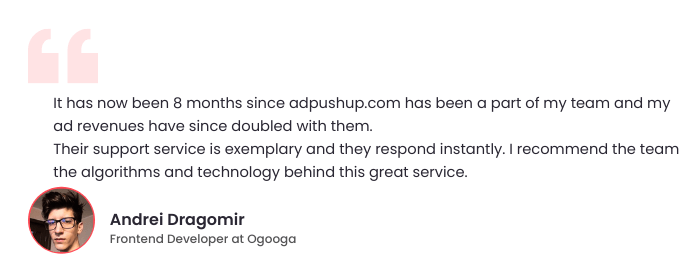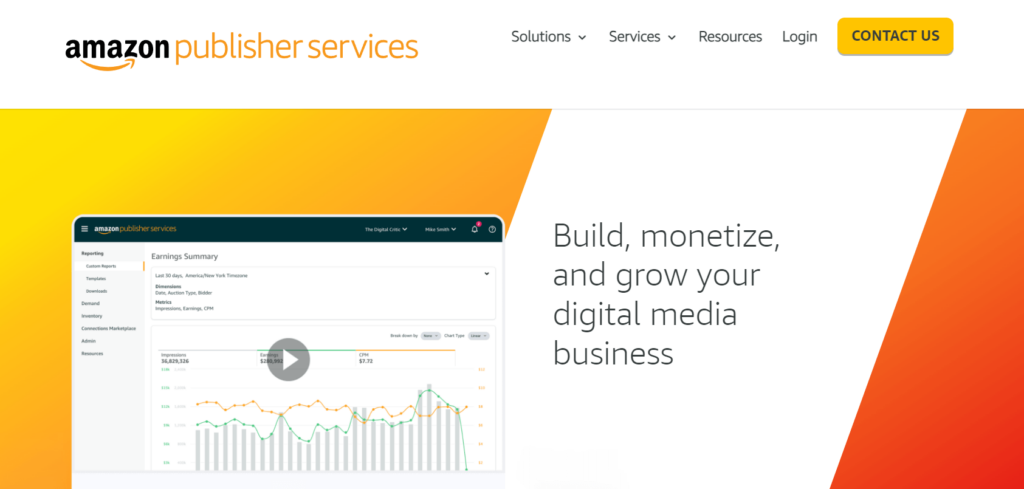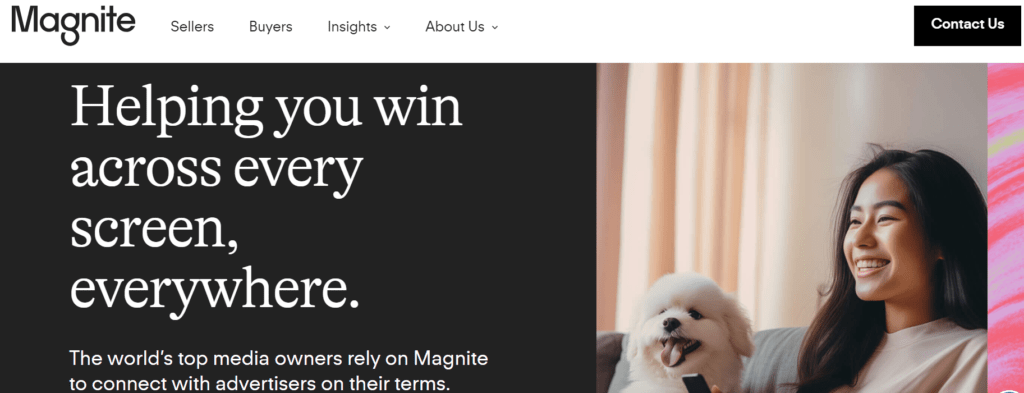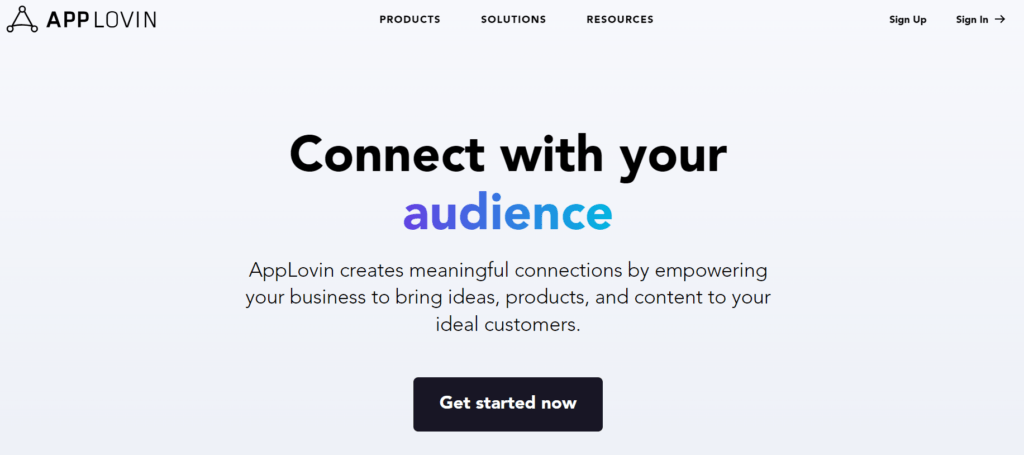Ad exchanges have revolutionized the AdTech industry by bridging a significant gap—a reliable connection between publishers and advertising entities. But what is an ad exchange, and how is it simplifying the lives of publishers and advertisers? Let’s find out.
Programmatic ad campaigns have taken the advertising industry by storm. Slowly yet steadily, they are becoming the new norm. But amidst the sea of ad campaigns running every minute, three main factors differentiate a good ad campaign from an excellent one – when, where, and how an ad is served to its audience.
Advertisers invest a lot of money and time to tap these three factors. They use every way possible to show the most suitable ad to their target audience. One of them is using an ad exchange. It is a digital platform that connects publishers to the most suitable advertisers.
But before that, publishers would negotiate the price of their media inventory with ad networks – individually! This process is, indeed, tiresome.
Enter ad exchange! This innovative platform brings SSPs (Supply-Side Platforms) and DSPs (Demand Side Platforms) together on the same platform. With its advanced technology-driven approach, ad exchanges satisfy the primary intents of both publishers and advertisers—increased revenue and enhanced ad targeting, respectively. In fact, ad exchange software can boost publishers’ ad revenue by 30%.
What is an Ad Exchange? (Ad Exchange Definition)
An ad exchange or programmatic ad exchange is a technology-driven marketplace that facilitates the buying and selling of ad inventory (advertising space) between publishers and advertisers. This eliminates the need for a third-party intermediary. Acting as publishers’ digital real estate, these ad inventories may include different types of ads, such as native ads, video, display, in-app, and mobile ads.
An ad exchange uses real-time bidding (RTB) that allows advertisers to bid on individual impressions in real time and optimize the efficiency of ad transactions.
Ad exchanges are the next “big thing” after real-time bidding, which has been in action since 2007. According to reports, the digital advertising market is on a rapid growth trajectory, with ad spending projected to have touched USD 740.3 billion in 2024. This offers businesses a huge marketing opportunity. This will only increase the usage of programmatic advertising and, thus, the need for ad exchanges.
What are the Types of Ad Exchange?
There are three primary types of ad exchanges – Open ad exchanges, private ad exchanges, and preferred ad exchanges:
1. Open Ad Exchange:
Also known as an open auction or public marketplace, an open ad exchange is a digital marketplace open to all advertisers and publishers. Open auction is perfect for an advertiser looking for a wide reach due to the presence of an array of publishers on the platform.
However, open ad exchanges don’t offer detailed information about publishers. At the same time, it is difficult to control or verify the ad inventory’s quality compared to private exchanges. Also, with millions of impressions flowing through ad exchanges daily, a concern for digital ad fraud has been growing as well. All these concerns have made private ad exchanges more popular among advertisers.

2. Private Ad Exchange:
A private ad exchange, also called a private marketplace (PMP), is an invite-only platform on which publishers decide which advertisers can bid, at what price, and under what conditions.
Unlike in open auctions, a private ad exchange offers publishers a degree of control over the advertisers or DSPs they wish to associate with. This allows them to form a more direct relationship with certain advertisers or brands, leading to more customized deals and negotiations between the parties. Private ad exchanges are increasingly becoming popular among premium publishers who want more control over their ad inventory and the advertisers they work with.
3. Preferred Ad Exchange:
A preferred ad exchange, or a preferred deal, offers a more traditional approach to selling and buying digital ad space. It allows publishers to sell their ad inventory to select advertisers at a fixed, negotiated price. This allows a customized yet stable income stream for publishers and fixed pricing for advertisers, fostering a more reliable and healthier relationship between the publishers and advertisers.
Apart from the above main three, four more types of ad exchanges are there:
4. Vertical Ad Exchange:
Vertical ad exchanges serve a particular industry or vertical by bringing together advertisers and publishers within a specific space. The main purpose of these targeted marketplaces is to provide an exclusive platform to address the special needs and interests of businesses operating within a niche industry.
5. Mobile Ad Exchange:
Mobile ad exchanges are a technology platform solely made for the buying and selling of mobile ad space. Such exchanges are optimized to cater to the unique challenges and opportunities of mobile advertising, often incorporating features like responsive ad formats and location-based targeting. With smartphones dominating the tech market, a mobile ad exchange is an ideal platform for businesses to enhance the effectiveness of their ad campaign.
6. Video Ad Exchange:
Video ad exchanges, as the name suggests, facilitate the buying and selling of video ad inventory. Supporting various video ad formats like in-stream and out-stream, they provide an on-point platform for advertisers wanting to engage their audience through fascinating visual content.
7. Native Ad Exchange:
Native ad exchanges aim for a smooth and non-disruptive user experience by seamlessly blending the ad into the content environment. This allows advertisers and publishers to maintain the organic flow of the content while delivering compelling promotional messages, thus driving high click-through rates.
Components of Ad Exchange/What Makes Ad Exchange Work?
The digital ad exchange has four major components which form its basis, namely:
- Real-time Bidding: This form of programmatic buying involves a split-second ad space auction on a per-impression basis. Multiple ad partners bid on a particular ad space simultaneously, with the highest bidder winning the space to display its ad.
- Demand-side Platform (DSP): DSP is software used by advertisers to buy ad inventory from publishers in an Ad Exchange through real-time bidding. It streamlines the ad-buying process by automating it, which allows for better ad targeting and optimization.
- Supply-side Platform: Also called sell-side platform, it’s an AdTech platform used extensively by publishers to manage their ad space and earn revenue. An SSP works by putting up the ad inventory for auction on an ad exchange platform and securing the highest bid for the publishers, hence generating revenue. Publishers heavily leverage supply-side platforms during real-time bidding.
- User: The online user who visits the website and starts the process. The auction happens as the website loads (often in milliseconds) and is shown to the user on the publisher’s website, marking an ad impression.
How Does an Ad Exchange Work?
Consider ad exchange to be a virtual marketplace. Now, this marketplace has many digital billboards (ad inventory) waiting for the ads to be displayed. Like a traditional billboard is judged on parameters like traffic count and location, the digital billboard is also evaluated, but on lines like page impressions, website traffic, audience, etc.
Based on the parameters, buyers (advertisers) place bids, and the highest bid wins the chance to show their ad on the digital billboard. Unlike traditional bidding, these biddings are algorithm-based and happen within 30 milliseconds. For perspective, it takes our eyes 300 milliseconds to blink! Here are the simplified steps explaining how an ad exchange works:
Ad Exchange Process: A Six-Step Overview
Step 1: Publishers sign up for an ad exchange
Step 2: After ad exchange login, publishers make their ad inventory available for sale and provide details about their ad space, ad format, size, and ad location on the webpage via the SSP.
Step 3: Whenever a user visits a publisher’s website, the ad server sends a request to the ad exchange via SSP to locate the appropriate ad based on the targeting criteria set by the advertiser. For example, an advertiser says that s/he will display ads for $1 for a thousand impressions to males between the age of 20-35 living on the western coast of the USA (pre-cached bid – a bid already fed in the AdUnit in anticipation of the visiting user).
Step 4: If no pre-cached bid is found, the ad exchange will send the request to all the buyers, letting them know the criteria, inventory details, and the base price set by the publisher. The ad exchange then selects the winning bid.
Step 5: The winning DSP passes instructions to the ad exchange for retrieving the ad creative. It is then communicated to the SSP and the publisher’s ad server.
Step 6: The ad server then serves the ad to the user’s device. Finally, the ad exchange charges a commission that is paid to the publisher.
In the process, publishers offer their ad inventory through a supply-side platform (SSP), which the ad exchange records as potential impressions. When a visitor arrives on a publisher’s page, their information is collected via cookies, and the ad exchange uses this visitor data to select the most relevant bidders.
Once a visitor’s data is collected, a bid request is initiated. A series of events happen once a bid request is placed. Just like a gear setup in a watch, all the gears in the AdTech ecosystem start operating to process the bid request.
What Happens After a Bid Request?
A bid request is triggered when a user visits the publisher’s website, which is received by the ad exchange. Along with the bid request, ad exchange also receives data related to the user, such as location and browsing history.
The ad exchange then forwards the bid request to advertisers who are interested in purchasing the ad space.
After this, the ad exchange collects all the bids and chooses the highest one as the winner. Then, it returns the signal to the publisher’s site and places the winning creative after retrieving it from the partnered ad server.
How an Ad Exchange Selects the Relevant Bidders for an Ad Space?
The answer is simple – via cookies. Whenever a user visits a website, they encounter a pop-up on their screen asking them to accept cookies. These cookies collect relevant information about the user, which are then stored with the SSPs and shared with the ad partners like ad exchanges.
So, when any user lands on a website, the ad exchange uses those cookies to know about the user, matches it with the criteria set by the advertisers, and sends requests to the relevant DSPs for the bidding process. Additionally, Exchanges store the campaign requirements and signal the advertisers whenever an opportunity is available to submit their bids.
What are the Benefits of an Ad Exchange?
The ad exchange is more than just an AdTech platform. It’s like a sorcerer’s glass ball that gives you a detailed insight into audience preferences and behavior. Even Google has it that data-driven organizations are 3X more likely to experience greater enhancements in decision-making. So why should you hold yourself back?
1. Benefits of Ad Exchange for Publishers
i. Dynamic and Fair Pricing
The ad exchange provides real-time market data to publishers, which they can use to adjust their ad space’s price in terms of demand. This can help them set a floor price and choose a minimum CPM (Cost-Per-Mile) to make a fair deal.
ii. Filtering Options and Better Control
The ad exchanges also come with filtering options which give publishers control over the ads shown on their page along with their chosen ad format and style. This option also helps publishers prevent their competitors from bidding on their inventory.
iii. Customization Options
Ad Exchange offers an array of customization options to publishers for styling the ads, such as corner styles, toggle font, colors, and so on.
iv. Provides Multiple Ad Formats
Ad exchanges also provide ad formats like video ads, which broadens the publisher’s revenue stream. We suggest experimenting with various ad sizes via A/B testing to determine the most effective fit for your website. Additionally, you can leverage Adpushup’s unique A/B testing tool, tailored specifically for publishers.
v. Diversify Ad Impact
Lastly, ad exchanges evaluate the publishers’ ad inventory, which opens up an opportunity for greater revenue growth. Moreover, they facilitate multi-platform advertising via cross-platform ad placements, diversifying the publisher’s audience pool.
2. Benefits of Ad Exchange for Advertisers
i. Precise Targeting
Advertisers get the ability to choose their target audience according to their business requirements, leading them to generate better results out of their ad campaigns.
ii. Filtering Options and More Control
Similar to publishers, advertisers also get to control the publishers they want to engage with, blacklisting those with whom they do not want to work. Ad exchanges also provide options like advanced bidding capabilities to get the best possible CPM.
iii. Better Ad Management
The exchanges also enable the advertisers to manage multiple aspects of their ad campaigns, such as preventing the same user from seeing the ad again and again.
iv. Cost-effective
Next, ad exchanges can help advertisers manage costs and run their ad campaigns without taking a toll on their pockets. Ad Exchanges generally come with various pricing models such as CPC, CPM, and CPA. Advertisers have the flexibility to choose the best possible pricing model to suit their needs.
Now that you’re aware of the nitty-gritty of an ad exchange, let’s understand what difference it shares with the SSPs and the DSPs.
Top 5 Challenges of Ad Exchange
While ad exchanges offer numerous benefits, they also come with several challenges that advertisers and publishers must navigate.
1. Ad Fraud
Ad exchanges are susceptible to various forms of ad fraud, including click fraud, impression fraud, and fake traffic. Fraudulent activities can lead to advertisers paying for non-existent or low-quality impressions, undermining the effectiveness and integrity of ad campaigns.
2. Brand Safety Concerns
Maintaining brand safety is a significant challenge in ad exchanges. Advertisers may find their ads displayed alongside inappropriate or controversial content, potentially damaging brand reputation. Ensuring brand-safe environments within the exchange is a continuous struggle.
3. Ad Viewability Issues
Ad viewability remains a concern, as not all served ads are necessarily viewed by users. Advertisers may struggle to ensure that their messages are seen by the intended audience, impacting the overall effectiveness of campaigns.
4. Ad Blocking
The rise of ad-blocking technology poses a challenge for ad exchanges, as users increasingly employ these tools to avoid intrusive or irrelevant ads. This trend reduces the reach and impact of ads, impacting the revenue potential for publishers.
5. Quality of Ad Inventory
Ad exchanges, especially open auctions, may not be transparent about the quality of ad inventory being provided. Lack of information on this front can make it difficult for advertisers to find a relevant ad space, making it challenging for them to make informed purchases.
Navigating through these complexities requires a nuanced understanding of the diverse types of ad exchanges and a strategic approach to harness their potential while mitigating potential risks.
Key Differences Among Ad Exchange vs SSP vs DSP.
Ad exchange, SSP and DSP are essentially the main components of programmatic advertising. SSP, or the supplier-side platform, serves the publishers. It manages the ad inventory and related tasks like securing the best bid price and choosing advertisers relevant to their audience amongst other things.
On the other hand, DSP, or the demand-side platform, serves the advertisers. The DSPs are mainly responsible for maximizing the ad spend, choosing the best ad marketplace, and targeting the relevant audience.
But what is the work of an exchange here? It brings the two parties together on a single platform for direct trading of ad inventory. In other words, it complements the operations of both DSPs and SSPs.
Ad Exchange Vs. Ad Server Vs. Ad Network
Even if you are well-versed in the programmatic advertising industry, the intricacies of ad exchanges, ad servers, and ad networks can be confusing.
For a quick recap, an ad exchange is a digital marketplace for real-time bidding on ad space. An ad network is more like a retail shop aggregating ad space and selling it at a fixed rate. However, an ad server is an ad management system that publishers use to manage and deliver ads.
Below is a table with differences summarized between the three for better clarity.
| Aspect | Ad Exchange | Ad Network | Ad Server |
|---|---|---|---|
| Function | Real-time buying and selling of ad space; allows bidding on impressions. | Collects and categorizes inventory; sells it for profit; less transparent. | Implements ad tags, gathers user data, and serves ads based on rules. |
| Objective | Provide a perfect seller-buyer match through real-time bidding. | Maximize publishers’ profit by selling inventory at the highest price. | Ensure seamless delivery of ads based on predefined rules. |
| Inventory Source | Aggregates inventory from multiple publishers. | Directly manages and controls its own inventory. | Manages and stores its own inventory for ad serving. |
| Pricing Model | Often uses real-time bidding (RTB) for dynamic pricing. | Typically uses a fixed CPM (Cost Per Mille) pricing model. | Pricing is not a function of ad servers. |
| Targeting Precision | Allows precise audience targeting and segmentation. | Targets audiences based on aggregated data from the network. | Depends on the ad server’s configuration; not a function of the ad server itself. |
| Control for Publishers | More control over pricing and inventory. | Less control over pricing and inventory; operates within network constraints. | Manages ad delivery based on predefined rules but not directly involved in pricing. |
| Competition | Encourages competition among advertisers in real-time. | Limited competition; buys from fixed inventory. | Not relevant; focuses on ad delivery rather than competition. |
| . |
Top 10 Best Ad Exchanges for Publishers
In case you are wondering where to start, here is an ad exchange list (best ad exchange platform) with their benefits:
1. Google AdX
Google runs its own ad exchange where Google Display Network partners can buy and sell ads. Google AdX comes under the umbrella of Google Ad Manager, offering third-party demand along with GDN.
It uses open auctions (preferred and programmatic deals) and private auction models (programmatic guaranteed) to make inventory exchange possible.
Google AdX is only available for premium publishers and advertisers. Small and medium publishers can access these services with the help of Google Network Partners (like AdPushup).
Features for Publishers:
- With account-level filtering, publishers can filter out the demand and creatives that they don’t want on their sites.
- Publishers can define various parameters (geography, ad sizes, layouts, ATF, and BTF ad units) for their revenue reporting and to better understand the inventory.
- Once publishers sign up with AdX, the platform handles everything from ad delivery to payments.
2. Amazon Publisher Services

Next on the list, Amazon Publisher Services offers multiple offerings, which include Transparent Ad Marketplace (TAM), Unified Ad Marketplace, and Connections Marketplace. It comes with a cloud-based suite enabling publishers to access tools like header bidding, an advertising marketplace, and a lot more.
Similar to the open bidding service offered by Google, Amazon offers server-side solutions and it’s mainly ideal for large-scale publishers.
Though it is generally preferred by large publishers, it does offer some access to mid-scale publishers. it’s important to understand that UAM (Unified Ad Marketplace) is available by invitation only. This means that even if you meet other criteria, you might not gain access to their ad marketplace unless specifically invited. So, for many, access to UAM could be out of reach.
3. Index Exchange
Index Exchange is another popular ad exchange that has created a marketplace where premium digital media companies come together and exchange inventory.
It offers complete control of inventory and pricing, along with providing access to quality demand. Premium publishers like Business Insider, The Economist, and The Telegraph work with the Index Exchange platform.
Features for Publishers:
- It is certified by TAG and is a member of the Coalition for Better Ads, which shows its commitment to serving only high-quality ads.
- Offers in-house inventory integration and maintenance for better buy- and sell-side results.
- The company is known for transparency when it comes to bid-level auction data and earnings and for its quality of demand sources.
4. Magnite

Rubicon Project (or simply Rubicon) is a global ad exchange that specializes in buying and selling inventories, facilitating over 1 billion deals every month. The Wall Street Journal, GAMELOFT, and eBay are some of the publishers who trust the Rubicon Project.
The company offers demand and campaign management for sellers and buyers. The company was also a contributor in the making of Prebid (with AppNexus), making them one of the top ad exchanges in the header bidding market.
Features for Publishers:
- It is designed for non-technical publishers. If required, publishers can also get manual assistance on request.
- It offers a unified platform where publishers can access global demand without having to go through multiple channels or services.
- Offers client-side, server-side, and hybrid header bidding solutions for better monetization.
5. OpenX
OpenX introduces publishers to a powerful programmatic marketplace. Their trademark offering, OpenAudience, empowers publishers with insights about their respective audiences.
The company also offers yield analysts to publishers to identify the true potential of their inventories. To keep ad fraud at bay, OpenX abides by anti-ad fraud measures. Moreover, the company was one of the contributors to the “Certified Against Malware” program.
CarGurus, Philly.com, and Graphiq are some publishers monetizing with OpenX.
Features for Publishers:
- It offers OpenX Bidder—header bidding solution that connects publishers with a premium marketplace of demand partners.
- OpenX predicts audience volume to help publishers monetize better. Its “Real-time Guaranteed” feature is known to help publishers improve seller-buyer relationships for more profitable deals.
- It has a mobile-optimized ad exchange designed to reach buyers interested only in mobile inventory, saving publishers time to find suitable mobile demand on their own.
6. SmartyAds
SmartyAds ad exchange offers a complete ad tech solution to publishers, advertisers, and agencies. It is an independent ad exchange platform with a premium marketplace.
The company delivers more than 2 billion impressions daily while working with 25K+ premium publishers. It assures unbiased trade and quality exchange while maintaining profits for the parties involved.
Features for Publishers:
- Precise targeting by SmartyAds gets publishers the right ads for their audience.
- Real-time analytics shows inventory performance by different layouts (banner, native, video) and different devices (desktop and mobile).
- A transparent and brand-safe environment that lets publishers design their layout while maintaining various ad standards.
7. ALX by APPLOVIN

ALX is a mobile ad exchange, supporting a diverse range of ad formats including including video, rewarded video, playable, native, rich media, and display ads. It works with 100+ DSPs and the ad inventory here in this ad exchange is bought programmatically on a per-impression basis. The company claims that it connects buyers with over 140,000 mobile apps on more than 2 billion mobile devices globally. AppLovin ensures that your traffic remains clean and legitimate by offering strong protection against invalid traffic.
8. Smaato
Smaato is an app-based ad exchange platform processing over 150 billion ad requests per month. The self-serve platform provides easy ad delivery with higher eCPMs.
Liftoff, Gameloft, and Outfit7 are some developers that use Smaato. It offers extensive demand, global reach, and seamless website integrations with the company’s code to drive higher revenue for publishers.
Features for publishers:
- Integrates real-time ad exchange to access dynamic demand from more than 450 sources around the globe.
- App publishers have options to access private marketplace, direct deals, RTB, and third-party mediation.
- Works with technologies like The Media Trust and GeoEdge in order to maintain ad quality standards, brand safety, and user protection.
Looking for more demand on your inventory, we can help with our partnerships with 20+ global demand partners. Learn more.
9. Yahoo (Formerly Known Verizon Media)
Previously known as Oath and Verizon Media, Yahoo, renowned for its search engine, operates one of the world’s largest ad exchanges. It’s an omnichannel exchange that allows advertisers to reach the audience across several platforms including CTV, mobile devices, and more. It provides a range of user-friendly features for both publishers and advertisers, seamlessly integrating across desktop, mobile, and tablet devices.
Features for Publishers
- Comprehensive ad inventory management tools
- Top-notch ad creatives
- Fully compliant with global privacy regulations, such as the GDPR in the European Union
10. PubMatic
Pubmatic is a publisher-centric ad technology company. It delivers over 64 billion daily ad impressions to 800M+ unique users across the globe.
The technology is available for web, mobile, and app publishers. Publishers like Dictionary.com, Livingly Media, and Times Internet are monetizing using Pubmatic’s technology.
Features for Publishers:
- OpenWrap—an open-source header bidding wrapper by Pubmatic enables client-side, server-side, and hybrid header bidding solutions.
- Real-time bidding technology with a large pool of bidders increases bid pressure and, hence, publisher earning potential.
- The platform detects and filters invalid traffic to ensure brand safety.
How to Choose the Best Ad Exchange For Publishers?
By now, you must have a fair understanding of ad exchanges, their functioning, and how they benefit both publishers and advertisers. Investing in a suitable digital ad exchange will certainly bring profits. But there are plenty of fish in the sea, and whether it is maximized ad revenue or the type of ads, it will solely depend on the fish you catch. There are certain points you must ponder over before zeroing in an exchange, such as:
1. How They Work with Publishers
Ad exchanges have their own way of building relationships with publishers. Some ad exchanges will give easy approvals and competitive rates. On the other hand, some exchanges individually select the advertisers and are open to working with publishers of any size.
2. Investigate Vulnerability to Fraud
As we discussed in this blog, ad exchanges can be prone to fraud due to the network of intermediaries that facilitate the buying and selling of ad impressions.. As impressions pass through various platforms before reaching their destination, it can lead to safety concerns regarding ad placements on your website.
But how can you tackle it? By checking the ad exchange’s anti-fraud capabilities. You should check for anti-fraud vendors to make sure only legit bid requests are allowed in the auction.
3. Understand the Advertiser Pool
Next, it is important to make sure that the ad exchange you’re choosing has a broad advertiser network. More advertisers mean more competition, which will bring in more bids, generating more revenue for the publishers.
4. Look For TAG Certification
Programmatic advertising has been plagued by various types of frauds like ad fraud, traffic invalid, ad stacking etc. If not careful, they can not only disrupt the user experience, but can also lead to revenue loss for the publisher.
To protect against such fraudulent practices, it is crucial to choose an ad exchange certified by the Trustworthy Accountability Group (TAG). The certified companies constantly take steps to combat various frauds in digital advertising to provide a safe platform to publishers and advertisers for deals in real-time.
5. Try Available Options
Most importantly, look at the different ad exchanges that are available and compare their features, pricing, and audience reach. Consider their size, reputation, and reliability as well.
Key Takeaways
– Ad exchange is a digital marketplace that enables publishers to sell their inventory to a bigger pool of buyers (ad networks, DSPs, and advertisers), conversely, advertisers get access to a large pool of ad inventories.
– Ad Exchange enables advertisers to easily purchase ads across multiple sites at once instead of negotiating purchases directly with specific publishers.
– Compared to ad networks, ad exchanges are more transparent because they enable buyers to see the exact price at which impressions are being sold for.
– Different types of ad exchanges include Open Ad Exchange, Preferred Deals, and Private Marketplace. Some of the best ad exchanges include Google Ad Exchange, Pubmatic, and OpenX.
We hope that by now you have complete clarity on “What is an ad exchange?”
If you need any assistance in ad revenue optimization for your business, get in touch with our team. AdPushup helps digital publishers generate maximum ROI from their ads on their websites. We have helped businesses achieve an average 35% increase in revenue since 2014.
Contact us today by filling a form down below to learn more about how we can help boost your ad revenue and grow your business!
Frequently Asked Questions
An Ad exchange connects thousands of publishers and advertisers by providing a platform to sell and buy ad inventories using its connections with various ad networks and supply-side platforms.
Ad exchanges are relatively more transparent as buyers get to see real-time bid price, impressions and accordingly place their bids. Many ad networks now buy their inventory from exchanges.
Ad exchanges permit anyone with permission to purchase ad inventory, making it a popular choice for ad networks, advertisers, and DSPs due to the wide range of options available. Publishers also benefit from using ad exchanges as they gain access to a large pool of potential buyers and can sell their advertising space more effectively.
As a search engine giant, Google owns and operates its own ad exchange called Google Ad Exchange (AdX). AdX is an open auction platform designed to facilitate the sale of publishers’ ad inventory to premium advertisers. It operates within the programmatic advertising ecosystem, leveraging real-time bidding (RTB) technology to help advertisers bid on available ad space in real time
OpenX
Pubmatic
Facebook Exchange
Yahoo Advertising
Index Exchange
and the list goes on.
A private exchange is a platform that is exclusive to a select group of advertisers, as determined by the publishers who control the marketplace. Unlike open ad exchanges, private exchanges are closed systems that limit the number of buyers to a handful of handpicked advertisers. Publishers on private exchanges maintain control over the conditions of ad sales, such as minimum pricing and specific buyers allowed to access their ad space.
Google AdX, or Google Ad Exchange, is the largest programmatic ad exchange. Google AdX conducts the first-price auction and sells display advertising space in real time.
Ad exchanges come in various types, including open ad exchanges that facilitate real-time bidding in a public marketplace and private ad exchanges, which are invitation-only platforms offering exclusivity to a select group of advertisers and publishers.
There are also specialized ad exchanges such as mobile ad exchanges, video ad exchanges, and native ad exchanges, each catering to specific formats and industry niches within the digital advertising landscape.
Large publishers or digital media companies with substantial traffic and diverse advertising needs stand to gain the most by having their own ad exchange. This gives them greater control over ad transactions, pricing models, and the quality of ad inventory. Additionally, companies seeking to innovate in the digital advertising space, optimize user experiences, and establish direct relationships with advertisers might find building a proprietary ad exchange advantageous.
Revenue generation through ad exchanges occurs by charging fees or commissions on transactions that occur within their platform. These fees are often a percentage of the winning bid or a fixed fee per thousand impressions (CPM) and contribute to the revenue generated by the ad exchange.
In the case of programmatic advertising, ad exchange plays a central role as the marketplace where automated buying and selling of digital ad inventory occur in real time. It facilitates programmatic transactions, enabling advertisers to bid on and purchase ad impressions through algorithms and data-driven decision-making processes.
Putting the benefits of ad exchanges aside, there are certain risks associated with the activity. Major among them is the potential for ad fraud, brand safety concerns, and the lack of transparency in ad inventory quality.
The judging of whether an ad exchange is right or not needs to be made by considering factors such as the scale of your digital advertising needs, the diversity of your target audience, and your willingness to navigate potential challenges like ad fraud and brand safety.
Ad exchanges make money by charging a fee or commission on transactions on their platform. It can be either a percentage of the winning bid or a fixed fee per thousand impressions.
Google AdX is the largest and most popular digital ad exchange platform amongst publishers. It conducts the first-price auction and sells display advertising in real time.
No specific body owns an ad exchange as it’s a type of ad software. However, there are many exchanges owned by various companies. For example, Google Ad Exchange is owned by Google.
Ad exchange brings publishers and advertisers together on a single platform to buy and sell ad space. On the other hand, advertisers use a DSP to engage in the bid on the ad exchange. All the data about the campaign is fed into the DSP, which it uses to decide which ad space to bid on.








